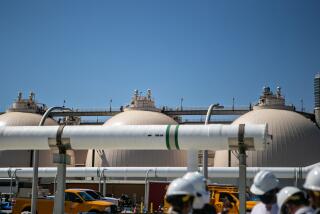Inspectors urge Japan to dump water from Fukushima plant into ocean

- Share via
Reporting from Tokyo — Nearly four years after Japan’s massive March 2011 earthquake and tsunami, the country has made “significant progress” toward stabilizing and decommissioning the ravaged Fukushima Dai-ichi nuclear power plant, international nuclear inspectors said Tuesday.
However, the nearly 160 million gallons of contaminated water stored on-site pose massive logistical challenges, and examiners strongly urged Japan to consider controlled discharges of the liquid into the Pacific Ocean once it is treated.
The situation at the crippled plant remains “very complex” and “the benefits [of discharges] could be very, very huge” said Juan Carlos Lentijo, who led the team of 15 inspectors from the International Atomic Energy Agency on a nine-day mission that follows surveys in April and November 2013.
Japanese officials have been reluctant to take such a step at the plant 160 miles northeast of Tokyo, fearing it might further antagonize local fishermen and other residents affected by the initial accident and its aftermath.
In the past year, Japan has succeeded in removing spent and fresh fuel from one reactor, Unit 4, and reduced the inflow of groundwater into the facility. It has also taken steps to clarify which entities are responsible for particular jobs, the IAEA team noted.
But about 80,000 gallons of groundwater continue to enter the plant per day, and building and maintaining storage tanks is increasingly taxing for the 7,000 workers toiling at the site, Lentijo’s team noted. In January, a laborer in his 50s who was inspecting an empty, 33-foot-tall storage tank fell into the vessel and died.
In wake of that accident, Japan’s nuclear regulator called on plant operator Tokyo Electric Power Co. to move toward discharges of treated water.
About half of the water stored on-site has been treated to remove most radioactive contaminants, the IAEA team noted, though current technology does not allow for the easy removal of tritium, an isotope of hydrogen.
Unlike other contaminants, which are suspended or dissolved in water, tritium actually modifies the water molecules and therefore is difficult to separate out.
Still, tritium is considered one of the least hazardous radioactive materials produced by nuclear power plants, and Lentijo said “controlled discharges are a normal practice in the industry.”
“Most of the nuclear power plants are discharging treated water,” he said at a news conference in Tokyo. “This is accomplished with negligible impact on the environment and the safety of the people.”
Japan’s Ministry of Economy, Trade and Industry has solicited demonstration projects from several companies for technology that might effectively treat the tritiated water. Orange County-based Kurion said it was awarded a $10-million grant in November for a pilot programs of its technology in Japan to see if it would be effective at Fukushima.
Among its other recommendations, the IAEA team encouraged Japan to narrow down the number of options being considered for the overall decommissioning plan and to reinforce “safety leadership and safety culture” systems.
A final report from the IAEA team is expected in late March.
Follow @JulieMakLAT for news from Asia
More to Read
Sign up for Essential California
The most important California stories and recommendations in your inbox every morning.
You may occasionally receive promotional content from the Los Angeles Times.







